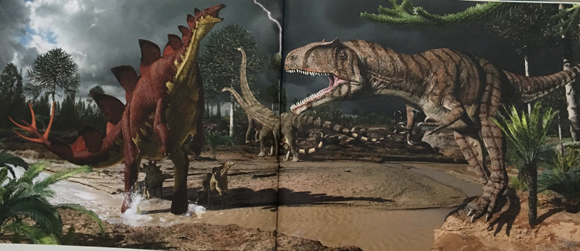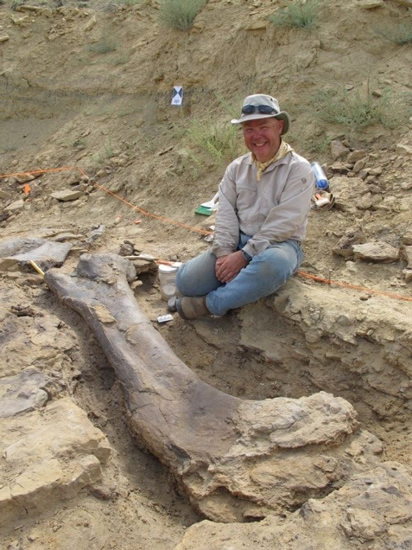Manchester University, the Morrison Formation and the “Jurassic Mile”
Scientists at Manchester University have joined forces with a major American Museum and European partners to map and explore an extraordinary Jurassic dinosaur site in the Badlands of Wyoming (USA). The University of Manchester will act as the academic leaders on this newly announced £20 million ($27.5 USD) research project to examine and eventually exhibit fossils excavated from a recently discovered palaeontological site nicknamed the “Jurassic Mile”. The “Jurassic Mile” represents deposits from the famous Upper Jurassic Morrison Formation.
Exploring the Morrison Formation in Collaboration with the Children’s Museum of Indianapolis
The University of Manchester’s Professor Phil Manning and Dr Victoria Egerton will be collaborating with scientists from the Children’s Museum of Indianapolis. Also involved are researchers from the Natural History Museum in London and the Naturalis Biodiversity Centre in Leiden (Netherlands). In total, more than a hundred scientists and academics from three countries will join forces to work at a dig site representing Upper Jurassic strata from the Morrison Formation of Wyoming. They hope to uncover new data to help explain the extraordinary diversity of the dinosaur biota known from this part of Laurasia in the Late Jurassic.
Life in the Late Jurassic – An Illustration of Morrison Formation Biota

Picture credit: Julius Csotonyi
The “Jurassic Mile”
Professor Manning, Dr Egerton and the team are calling the fossil-rich, mile-square plot of land, the “Jurassic Mile.” There are four main quarries within the multi-level, 640-acre site that offer a diverse assemblage of Morrison Formation articulated and semi-articulated dinosaurs that has also yielded associated animals and fossil plants. In addition, trace fossils in the form of dinosaur trackways have been identified, such tracks are rare in this part of the world.
Commenting on the significance of this collaborative field work, Professor Manning stated:
“It is splendid that such an important site has been discovered at just the right time, as the science of palaeontology is adapting existing and new imaging techniques to unpick the fossil remains of extinct life. The imaging work that we undertake at Manchester is already world-leading and this is a great opportunity to develop this research with other world-class institutions.”
A Remarkable Fossil Assemblage
Nearly six hundred specimens, weighing more than six tons, have already been collected from this site over the past two years, despite the fact that only a fraction of the area has been explored. Fossil bones found to date include the remains of an 20-metre plus brachiosaur and a 27-metre-long diplodocid. Giant sauropods had giant bones, one of the recent discoveries is a 2-metre-long brachiosaur scapula (shoulder bone), numerous plaster-coated burlap jackets containing articulated bones are the reward for the researchers after a successful field season.
At a press conference, held today, the discovery of an extremely well-preserved 1.5-metre-long sauropod femur (thigh bone), was announced.
Professor Phil Manning (The University of Manchester) with the Sauropod Femur
Picture credit: The University of Manchester
Dr Jeffrey H. Patchen, President and CEO of The Children’s Museum of Indianapolis commented:
“We are bringing together an extraordinary international team for the first time that will critically analyse portions of the Morrison Formation in new ways. This project reflects a natural synergy between three world-renowned museums, their research scientists and highly-respected research universities, each providing unique elements to complete one of the most interesting chapters in the evolution of Earth.”
Prehistoric Flora and Fauna
Dr Egerton from the Department of Earth and Environmental Science (Manchester University), explained:
“The preservation quality and sheer amount of plants at the Jurassic Mile is extraordinary. During this period, there were no flowering plants and this site provides significant insight to what these giant animals ate and how they may have grown to be so large.”
The Jurassic Mile project is already utilising cutting-edge science from the international team. The University of Manchester scientists will employ the Stanford Synchrotron particle accelerator along with some of the most powerful computers on the planet, to help resurrect the Jurassic and unearth the lost world and forgotten lives of some of the most remarkable terrestrial animals that have ever lived.
Everything Dinosaur acknowledges the assistance of a press release from Manchester University in the compilation of this article.
For models and replicas of prehistoric animals from the Morrison Formation: Dinosaur and Prehistoric Animal Models.
Visit the Everything Dinosaur website: Everything Dinosaur.







Leave A Comment